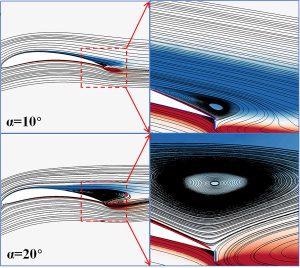Wind energy depends on effective wind turbine blades, which serve as airfoils, structures similar to an airplane wing. Air flow control accessories, which are the same as those discovered in aircraft, enhance the aerodynamic performance of the turbine blade.
 Airflow patterns around a Gurney flap. Image Credit: Liming Wu, Xiaomin Liu, Yang Liu, and Guang Xi.
Airflow patterns around a Gurney flap. Image Credit: Liming Wu, Xiaomin Liu, Yang Liu, and Guang Xi.
In the Journal of Renewable and Sustainable Energy, by AIP Publishing, researchers from China illustrate a bionic method integrating features of a seagull’s wing along with an engineered flow control accessory, called a Gurney flap. This can significantly enhance the performance of wind turbines.
A Gurney flap looks like a compact tab protruding at right angles from the wing’s trailing edge. Its existence upsets wind flow patterns and is specifically effective at enhancing performance at low angles of attack. In the field of aerodynamics, the angle of attack is known as the angle between a line through the center of an aircraft wing and the forthcoming flow of air.
Even though Gurney flaps enhance the performance of airfoils at low attack angles, they are not ideal for huge angles of attack. The study performed by the researchers has shown that although Gurney flaps considerably enhance the performance of wind turbines in certain situations, the turbine speed will be decreased.
Bionic flow control is considered to be a comparatively new method that mimics biological flight control systems — namely, feathers and wings. The concept comes from the observation that at the time of landing or in a gust of wind, the feathers on the top of a bird’s wings will tend to protrude, thereby making a natural flap.
Computational and experimental studies display bionic feather-inspired flaps that can increase lift and delay the start of stalling at high angles of attack. Irrespective of their benefits, adding bionic flaps could also decrease lift, especially before a stall sets in. Hence, the investigators attempted a method integrating Gurney flaps with bionic features.
For the best aerodynamic performance to be achieved, the researchers simulated the use of the integrated flow control accessory in a range of situations, such as high and low angle of attack and pre- and post-stall scenarios. The researchers made a comparison of their computational simulations to experimental results for an aircraft wing experiencing a dynamic stall.
The overall trend of the calculated lift curve is in good agreement with the experimental measurement results. Therefore, our simulation accuracy is considered acceptable, because the dynamic stall and its control are notoriously difficult to predict.
Xiaomin Liu, Study Author, Xi'an Jiaotong University
According to Liu, the integrated flow control accessory helps in the efficient improvement of the lift coefficient of the airfoil.
For angles of attack in the range 16 to 24 degrees, the maximum lift coefficient of the airfoil is increased by 15% when a combination of Gurney flap and bionic flap is used.
Xiaomin Liu, Study Author, Xi'an Jiaotong University
Journal Reference:
Wu, L., et al. (2022) Using the combined flow control accessory to the aerodynamic performance enhancement of bio-inspired seagull airfoils. Journal of Renewable and Sustainable Energy. doi.org/10.1063/5.0079060.